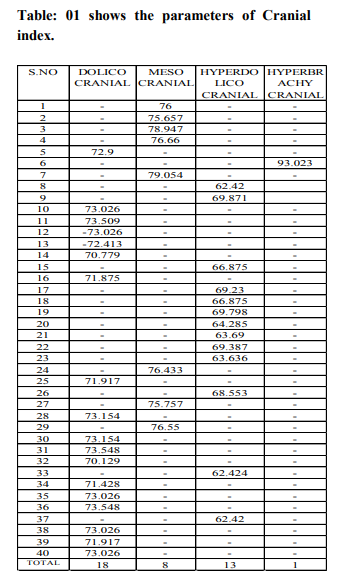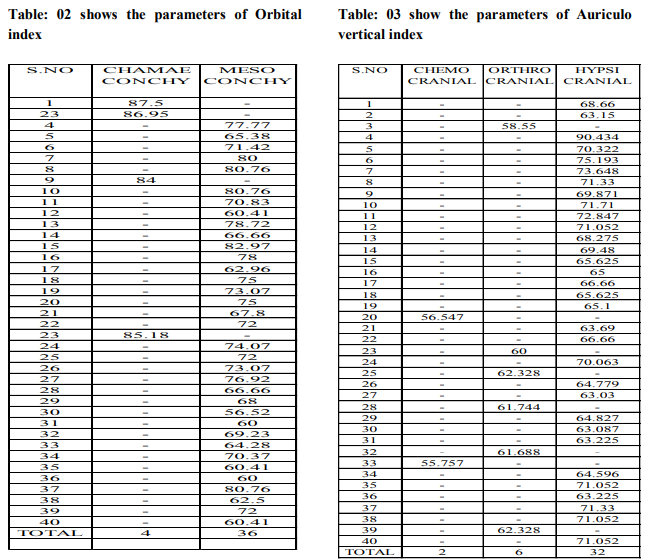IJCRR - 5(14), July, 2013
Pages: 83-87
Date of Publication: 29-Jul-2013
Print Article
Download XML Download PDF
A STUDY OF CRANIAL, ORBITAL AND AURICULO VERTICAL INDEX OF ADULT HUMAN SKULLS OF NORTH COSTAL ANDHRA POPULATION OF SOUTH INDIA
Author: P. Sri Devi, Raju Sugavasi, B. Indira Devi, K. Vijaya Lakshmi
Category: Healthcare
Abstract:Introduction: Craniometry is the technique of measuring the various dimensions of bones of the skull. Craniometry has been widely practiced in anthropology to attempt scientifically justify the segregation of society based on race. Cranial index and cranial indices are helpful in differentiation of racial and gender difference. Meterials and Methods: In the present study 40 available human adult skulls have been taken up from MIMS, Nellimarla, vijayanagaram, belongs to costal region of Andhra Pradesh. This study conducted to investigate the cranial index, orbital index and auriculo vertical index of the UN known sex of dried adult human skulls. Results: In the present study concluded that, the Mean cephalic index is 71.6 mms and most of the skulls are Dolico cranial type, Mean orbital index is 72.1mms and the Orbits belongs to skulls were Hypsi cranial type and Mean auricular height is 66.52mms, the skulls are Hysi cephalic type. The good knowledge of the cephalic dimensions of the skull can guide the surgical management related to the orbital and auricular pathologies.
Keywords: Craniometry, skull, orbital index, Cranial index
Full Text:
INTRODUCTION
Cephalic index is an important parameter for deciding the race and sex of an individual whose identity is unknown. Cephalic dimensions and cranial indices are considered as simplest and most efficient way to indicate racial differences (Chaturvedi et al, 1963). Variation between and within the population is attributed to complex interaction between genetic and environmental factors (Kasai et al, 1993). The cranial anthropometry can be helpful in the study of human growth variation in different races, for clinical diagnosis and treatment (Poswillo et al, 1963). Craniometry is important in forensic practice where cranial remains are compared with existing photographic and radiographic records (Williams et al, 1995). (El-Feghi et al, 2004) stated that Cephalo metry is the scientific measurement of the dimensions of the head, usually through the use of standardized lateral skull radiographer cephalograms. Cephalic index is very useful anthropologically to find out racial differences. (Patnaik VVG et al, 2001) orbital anatomy, the orbital cavities, which form the subject of this work, are situated on either side of the saggital plane of the skull between the cranium and the skeleton of the face. (Soames RW et al, 1999) anatomy represents, each orbital cavity is essentially intended as a socket for the eyeball and also contains associated muscles, nerves, vessels and in essence lodges the visual apparatus.
METERIALS AND METHODS
A total number of 40 adult human dry skulls of unknown sex and age were taken for this study from the department of anatomy, Maharaja’s institute of medical sciences, Nellimarla, vizianagaram, located in north costal region of Andhra Pradesh in south India. The dry skulls which are available in the department belong to same ethnological category as that of the subject from whom brains were obtained. The measurements for the dimensions of the Craniometry were taken by using a manual vernier caliper calibrated in millimeters. Cranial index (Maximum length: the distance between glabella to the furthest point at the occiput, Maximum breadth: measured by right angles to the saggital plane) was calculated by the following formula Maximum length of cranial cavity × 100 = Cranial index Maximum breadth of cranial cavity Orbital index (orbital length: maximum distance between the upper and lower margins of orbital cavity. Orbital breadth: distance between the mid points of medial and lateral margins of orbit) was calculated by the following formula Orbital height × 100=Orbital index Orbital breadth Auriculo vertical index (Distance between the external acoustic meatus to bregma and maximal cranial length) was calculated by the following formula Auriculo bregmal length ×100=Auriculo vertical index Maximum cranial length Classification of cranial index: According to Garson1 Skulls were cla ssified as following, lower than 64.9 called as Ultra Dolico cranial, 65.0 to 69.9 as Hyper Dolico cranial, 70.0 to 74.9 as Dolico cranial, 75.0 to79.9 as Meso cranic, 80.0 to 84.9 as Brachy cranic, 85.0 to 89.9 as Hyper brachycranic and higher than 90.0 as Ultra Brachy cranic. Orbital index is classified as, Chamaeconchy is characterized by an orbital index is below 75.9, mesoconchy is ranges from 76.0 to 84.9 and 85.0 or higher the ratio is called as hypsiconchy. According to the vertical cephalic index head shapes were classified as chamaecephalic (57.9 > VCI), orthocephalic (58.0 < VCI > 62.9) and hypsicephalic (63 < VCI).
RESULTS
In the present study the Mean cranial index is71.6mms (Table: 01) out of 40 skulls 18 skulls have a cranial index between 70-74mms they are Dolico cranial, 8 skulls have a cranial index between 75-79 mms they are Meso cranial, 13 skulls have a cranial index between 65-69 mms, they are Hyper Dolico cranial and 1 skull is having a cranial index of 93 mms, that is Hyper Brachy cranial type. Mean orbital index is 72.1 mms (Table: 02) 36 skulls have orbital index up to 32.99 and they are classified as Chamaeconchy, 4 skulls have orbital index of 83 - 89.99 their orbits are Mesoconchy type. Mean auricular height is 66.52 mms (Table: 03) 2 skulls are belongs to chemo cranial since the auricular index is up to 57.9 mms. 6 skulls belongs to orthro cranial type of classification since the auricular index is 58-62.9 mms, rest of 32 skulls are Hypsi cranial.
DISCUSSION
Many authors conducted Craniometric studies on dried skulls in India as follows, (Chaturvedi RP et al, 1963) conducted a study on 115 skulls concluded the mean cephalic index was 70.75 and those skulls related to the Dolico cephalic type. (Jaysingh P et al, 1979) conducted study on 300 human skulls, concluded the mean cranial index was 74.35 and in this study 57.3% skull belongs to dolico cephalic group. According to (Usha Dhall et al,1998) among the 89 adult skulls belonging to the North Indian population 78 skulls dolicocephalic, 10 mesocephalic and 01 brachycephalic and concluded most of the North Indian skulls belong to dolicocehalic group. (Sha et al, 2004) reported the mean cephalic indices within different Indian groups were ranges from 79.50 to 80.81. (Seema et al, 2011) reported mean cephalic index was 72.56 conducted a study on 62 north Indian skulls. According to (Vishal Manoharrao Salve et al, 2012) studies, Out of 136 (77 male and 59 female) dry human skulls The mean of cranial index in males and female was 72.47 ± 5.13 and The mean of cranial index in males was 70.18 ± 3.39 and in females was 74.96 ± 4.31. (Adejuwan SA et al, 2011) reported mean cephalic index was 72.54 from 85 skulls. (Bharati et al, 2001) It was interesting to note that cephalic index varies significantly among populations in different geographical zones. Some authors reported the mean orbital index as follows, According to (Ukoha et al, 2011) study show that the orbital index of Megaseme category of male Nigerians was 89.21. (Fawehinmi et al, 2008) reported an orbital height of 40.6mm and a breadth of 44.5mm In Port Hacourt, Southsouth Nigeria. (Ezeuko CV et al, 2007) Studies on orbital cavity dimensions have involved the use of anterior and lateral skull radiographs.
CONCLUSION
The conclusion of present study revealed that, most of the skulls are Dolico cranial type and the skulls Orbits are Hypsi cranial type and according to auriculo vertical index the skulls are belongs to Hysi cephalic type. Many previous studies reported the mean craniometric values in India but the present craniometric study investigates cranial, orbital and auticular index of dried human skulls especially in the North costal Andhra population of south Indian region.
ACKNOWLEDGEMENTS
The authors are greatful to Dr. Dr. B Narasinga Rao, Professor and HOD of Anatomy and, we would like to thank academic staff for their proper guidance, and encouragements. I am very much greatful to the research scholars and so many authors whose efforts have helped me to update my knowledge of Anatomy.
References:
1. Adejuwan SA, Salawau OT, Eke CC, Akinlosotu WF and Odaibo AB. A craniometric study of Adult human skulls from south western Nigeria: Asian journal of Medical Sciences, 2011; 3(1): 23-25.
2. Bharati S, Som S, Bharati P and Vasulu T. S. Climate and head form in India: Am. J. Hum. Biol, 2001; (13): 626–34.
3. Chaturvedi RP and Harneja NK. A cephalo metric study of human skulls: Journal of Anatomical Society of India, 1963; (12):93- 96.
4. Chaturvedi RP and Harneja NK. A cephalo metric study of human skulls: Journal of Anatomical Society of India, 1963; (12):93- 96.
5. Dhall U, Gopinath K. Sutural bones in North Indian population: J. Anat Soc India, 1998; 47(2): 25-26.
6. El-Feghi I, MA. Sid-Ahmad and M. Ahmadi, 2004. Automatic localization of craniofacial landmarks for assisted cephalometry: Pattern Recognition, 37: 609- 621.
7. Ezeuko CV, Aligwekwe AU, Udemezue OO, Ejimofor OC. Orbit Dimensions and Bony Inter orbital Distance in Southeast Nigerians: A Radiologic Study: J Expt and Clin Ana, 2007; 6(2).
8. Fawehinmi HB, Ligha AE, Chikwu P Orbital Dimensions of Nigerian Adults: Jobiomed Afr, 2008; (6):1-2.
9. Jaysingh P, Arora A K, Gupta C D, Dua S, Pandey D.N. Craniometric study of skulls of Uttar Pradesh: J. Anat. Soc. India, 1979; 28(3):127-131.
10. Kasai KLC, T Richard and T Brown. Comparative study of craniofacial morphology in Japanese and Australian aboriginal population: Hum. Biol, 1993; (65): 821-832.
11. Patnaik VVG, Bala Sanju, Singla Rajan K. Anatomy of the bony orbits- Some applied aspects: Journal of the Anatomical Society of India, 2001; 50(1):59-67.
12. Seema, Mahajan A and Gandhi D. cephalometric study of adult human skulls of north indian origin: International Journal of Basic and Applied Medical Science, 2011; (1): 81-83.
13. Shah GV, Jadhav HR. The Study of Cephalic index in Students of Gujarat: J. Anat. Soc. India, 2004; 53 (1): 25-26.
14. Soames RW. Skeletal systems. Williams P.L Bannister LH , Berry MM Collins P, Dyson Mary, Dussek J, Ferguson MW, ed.Grays. Anatomy the anatomical basis of medicine and surgery; churchill livingstone. 38th ed. 1999: pp 555.
15. Ukoha U , Egwu OA , Okafor IJ , Ogugua PC , Onwudinjo O ,Udemezue O. O: Int J Biol Med Res, 2011; 2(3): 688-690.
16. Vishal Manoharrao Salve, Pradeep Sundar Londhe. A Craniometric Study of Adult Human Skulls from Andhra Pradesh: NJIRM, 2012; 3(1): 63-66.
17. William PL, Bannester LH, Berry MM, Collins P, Dyson M, Dussek JE and Ferguson MWJ: Gray’s Anatomy. Soames R.W: Churchill Livingstone; London: 38th Edn : 1995; pp 612.


|






 This work is licensed under a Creative Commons Attribution-NonCommercial 4.0 International License
This work is licensed under a Creative Commons Attribution-NonCommercial 4.0 International License